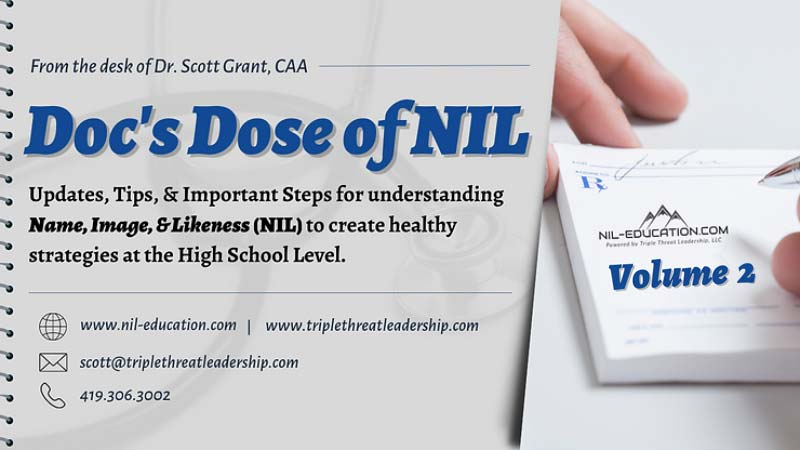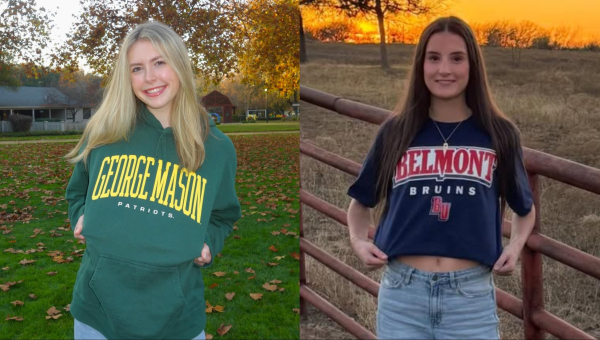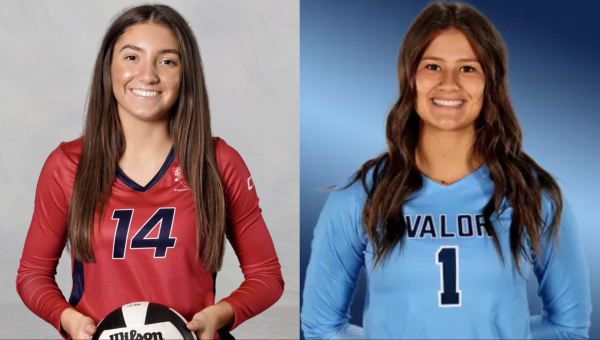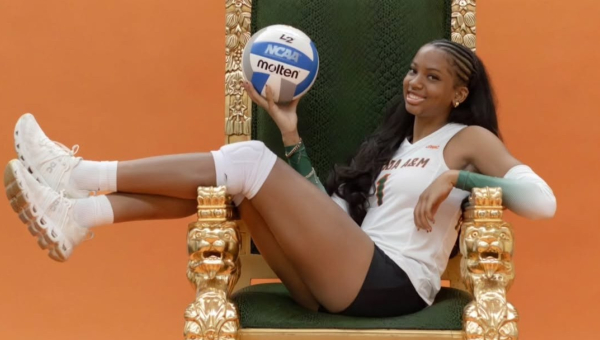
This content is provided FREE through our partnership with Dr. Scott Grant and Triple Threat Leadership/NIL Education to bring your family resources to learn the ins and outs about NIL, including the rules (each state is different), tactics, pitfalls, and marketplaces to take advantage of exciting opportunities available to student athletes.
A question I often receive from AD's that asks, My state just passed a policy / bylaw / regulation allowing NIL for High School Student Athletes….So what do I do now?
As we’ve noted in the previous two editions of Doc’s Dose of NIL, there are now 26 states (as well as the District of Columbia) that allow Name, Image, & Likeness (NIL) monetization for High School Student Athletes.
Whenever a new state approval or pending discussion happens, I usually get quite a few emails / dm’s / or calls from Athletic Directors asking me questions about it because for the most part, there hasn’t been much proactive preparation by any State Athletic / Activity Associations prior to the change.
On the contrary, many State Athletic Director Associations (please note that these are different from the State Athletic / Activity Associations - confusing, I know! - More to come on that in a later Dose), have at least provided a session or two at their state conferences for their respective Athletic Directors related to Name, Image, & Likeness.
Over the past two years, I’ve presented at numerous of these State Athletic Director conferences in areas where NIL wasn’t allowed yet, helping them dig in to understanding what it looks like at the HS level, as well as things to consider as it progresses into their states! Interestingly enough, at nearly every one of those conferences many of the AD’s said it wouldn’t be coming to their state any time soon, and at each of them at this point, it’s now been approved and in place.\
Additionally, because I'm a policy geek and a former High School Athletic Director with a doctorate in Educational Leadership and Policy Studies, each time a new policy is passed, I loved digging in to the intricacies with the focus on, “If I was an AD in this State, what would I specifically need to know?”
We all know that being an Athletic Director is one of the toughest, most time consuming jobs there is within a school district, and the amount of down time that AD's have to strategize and consider what’s coming is minimal, so the goal today is to provide a simple set of key questions to ask when NIL discussions in your state are occurring at the State Athletic Association level, or when they eventually pass and move forward.
#1: What am I EXPECTED to do from a State Association Level?
Since each state high school athletic association governs its own regulations without the oversight of a singular national governing body such as the NCAA, you begin to realize that while many of the high school NIL policies / bylaws are similar in some respects, they’re also very different.
I remember working as an Assistant Athletic Director early in my career and when new regulations came out, we always had a meeting with the key question at the forefront of, “Ok, since this is here now, what is the State Athletic Association REQUIRING US to do?”
You’re the first line of defense (and offense) for your school district in regards to State Athletic / Activity regulations / bylaws / policies.
As the AD:
You’re the one that is going to get asked the questions.
You’re the one that will be expected to know how this impacts your school district.
You're the one your internal and external stakeholders will expect to have a plan moving forward
So ensuring that you understand the policy frontwards and backwards in regards to the overall strategic planning needed to help your school, and day to day impact it may have on your work requirements is absolutely necessary.
#2: WHO DO I CONTACT with questions that will answer / know?
Let’s face it, you’re going to have questions.
And you’re going to need some help.
What I’ve found is that many State Athletic Associations are approving these regulations, but aren’t equipped or organized internally to handle the questions from their constituents (The AD’s) to support them appropriately.
Some state athletic associations employees have never been Athletic Directors, and now are being charged to handle an extremely complex issue that most Athletic Directors are fearful of.
So what happens?
Many companies and consultants, including myself, will say “that’s what we do, hire us!" or "we can help you with that", and as you’ve probably noticed, many State Athletic / Activity Associations are declaring specific entities as their “Exclusive NIL Educational Provider”.
While there are some really great organizations and support out there (and some really not so great ones too), there still must be some type of specific department / person within the State Athletic / Activity that is a point of reference before just shipping you off to a 3rd party who unfortunately may not be up to date with your specific state’s policy, or the intricacies of what this looks like at the High School Level. A lot of these educational providers have their hands in a lot of cookie jars, at a lot of different levels.
For example - this past week I had a call with an AD in a state where NIL is under consideration and I asked, “Does your State Athletic / Activity Association have a compliance officer, or someone that you can contact with questions on policy elements?
After a quick pause, the person said, “our state’s staff is minimal, and unfortunately struggles to manage the communication and handling of questions regarding the regulations we currently have, let alone adding this on top. Getting into contact with them and getting a quick answer back can already be hard enough.”
While I know most State Athletic / Activity Associations can be understaffed, that response is concerning, and something AD’s within each state need to collaboratively question and request / expect of their State Athletic / Activity Association as the integration of NIL begins, and or continues with their respective state.
Which brings us to the final consideration:
#3: What SUPPORT DO I HAVE to help prepare a strategic plan to educate my stakeholders?
Let’s face it, most policies at the high school level don’t allow schools or their employees to do much of anything. Almost all have guidelines stating that you cannot be part of any administering of deals, or creating NIL opportunities for your student athletes.
AD's can really can only do one thing, which happens to be the most important, and that is...
Build an Educational Plan for our district and your internal / external stakeholders.
Sometimes people think I’m crazy because I continue to shout it from the rooftops, but this is where I’m the most passionate about helping because I firmly believe that NIL provides an opportunity for high school educational based athletics to come front and center, pushing forward necessary life skills education by utilizing NIL as the driver, allowing schools to do what they do best - EDUCATE!
Additionally, when I sit down with schools and dig into these pieces, most schools already provide elements of this education, so building a strategic plan to encompass it all together is actually extremely close within their grips!
I firmly believe that this piece is too often overlooked due to the fact that there are so many things flying through people’s minds when NIL becomes allowed within their State, and because I don’t think many State Athletic / Activity Associations are providing help in the best way possible...
But to be fair, they don’t know what they don’t know.
As state athletic / activity associations continue to partner with NIL Education providers and sell this need by AD’s as an asset they now control, those deals are often based on a financial payment from the NIL company that is provided to the State Athletic / Activity Association in the form of a partnership, which in return provides access to their Athletic Directors / Schools.
This doesn’t always mean that they’re providing the best education, but rather, the company that is often able to pay the highest price usually wins.
I get it, that's business.
The unfortunate part is that sometimes this money doesn’t trickle down to support the Athletic Directors or their Athletic Directors Association, other than in terms of a few opportunities of engagement built into the agreement such as a presentation at their conference, or a speaking engagement at a breakfast at the state championship, or an email / social media post with a branded educational document.
Additionally, support from this entity is usually required to be purchased by the school themselves, but as the AD’s have relayed time and time again, they often feel required to utilize whatever their State Association sends down the pipeline, and they don't know of other options.
While the intent often is good, some State Athletic / Activity Associations get away from #2 above, by saying to their Athletic Directors -
“You have questions? Here is our exclusive NIL educational provider, go ask them.”
No matter what each individual school district decides to do, which ultimately is up to them, and whether you have SUPPORT from your State Athletic / Activity Association or not, Athletic Directors should consider the following:
- What does our school/community “space” look like, and what type of pressure / engagement with NIL may occur?
- What type of education best fits for my internal / external stakeholders, and what do they need NOW and ongoing in the FUTURE?
- In person? Virtual? During the day? In the evening?
- Do any of them even know what NIL is?
- How will we educate school admins, coaches, student-athletes, parents, as well as our community stakeholders?
Let’s face it, there’s more than just an NIL deal potentially happening in your district….
There is initial and ongoing education needed about understanding contracts with minors, execution of those contracts aligned with the state policies, tax implications, branding & publicity, protective rights, potential impact on recruiting, and much, much more…
Additionally, schools need to have conversations about their own internal strategy and the development of needed structures by asking questions such as:
- What type of policy and procedures do we need internally, and do those need to be board approved? If so, how long does that take?
- Is the state policy requiring us to do something, if so, what structure do we have in place to do that?
- For example - in some states, student-athletes are required to submit potential NIL agreements to their Athletic Directors to ensure they don’t violate the amateurism policy of the State Athletic Association. When this is part of the policy, I always ask AD’s - so what’s the process for that?
- Who will they submit those to?
- When and how will submissions be accepted?
- How long will you have to look it over before you provide something in writing back to them that it doesn’t violate the amateurism regulations? (Because we all know you may have a student-athlete bring you a potential proposal on a Thursday, expecting something back on Friday morning)
- What will that process look like? An email? A letter in writing? Ultimately - how will you CYA?
- What happens if a kid signs an NIL deal and doesn’t submit it for approval? Do you have a procedural layout for this in your student-athlete handbook?
While I know these questions always make AD’s and school administrators heads spin, it’s important to talk through them with your admin team to ensure that #1 is covered, while also figuring out where you’re going to get #3 to help you through all of this.
I firmly believe that by taking these three elements into consideration when preparing your district for what’s to come with NIL, it provides an opportunity to get “close” with the state NIL policy, and fully clarify the following from your State Athletic / Activity Association:
What am I expected to do?
Who do I contact for help?
What support can / will they provide?
26 states already, and more coming soon.




